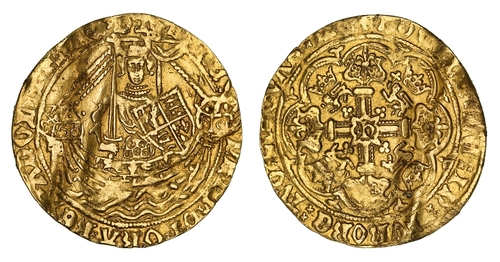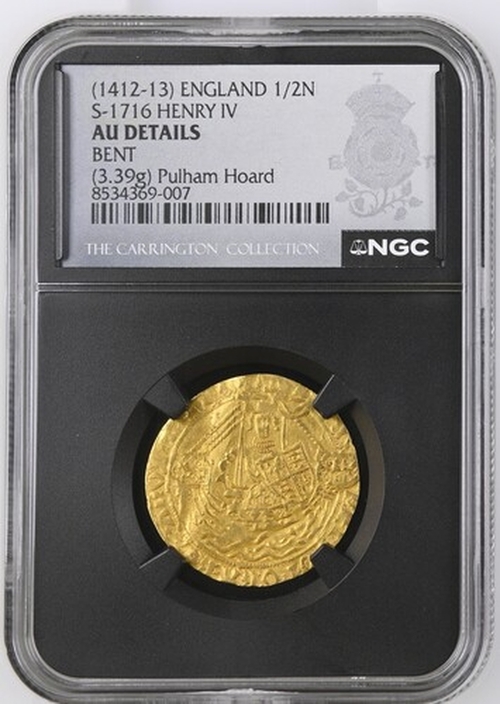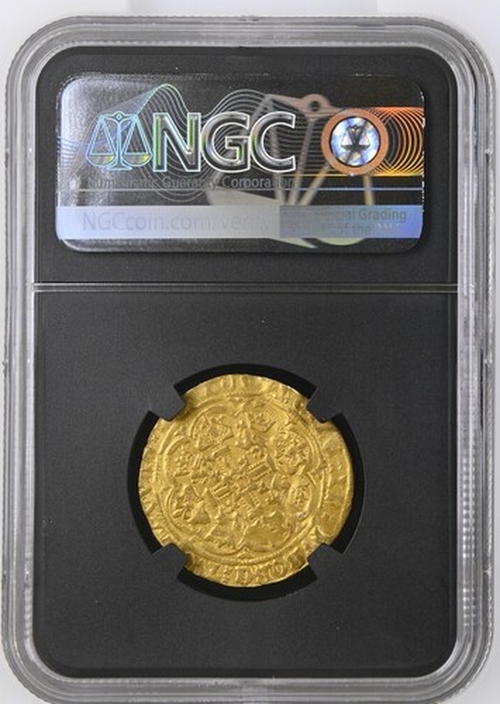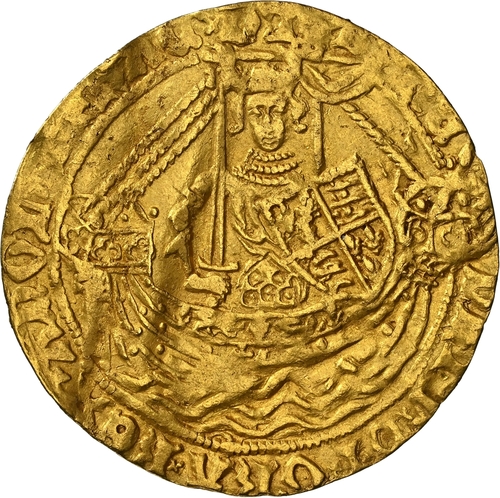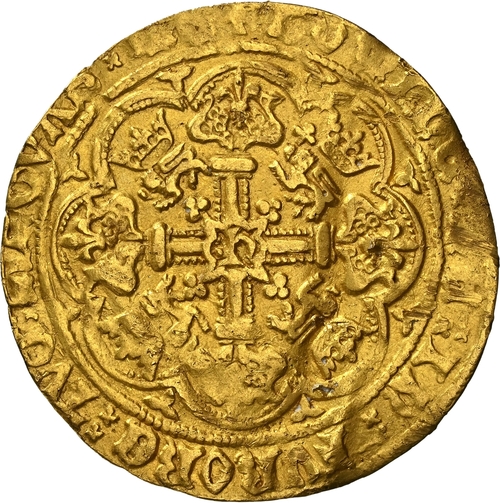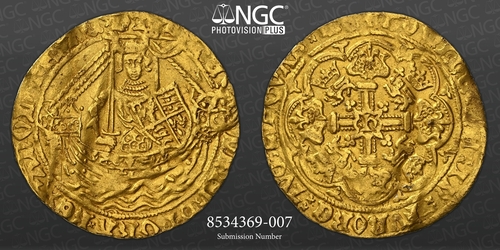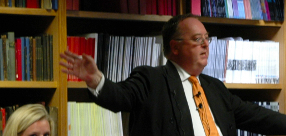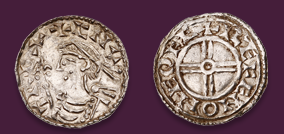Auction: 25005 - The Carrington and Pallas Collections of Exceptional English and Anglo-Gallic Gold Coins and Proof Sets
Lot: 571
(x) NGC AU | Henry IV (1399-1413), Light Coinage, Half-Noble, current 12 April 1412 - 1413, Type IV, Tower (London), hE | NRIC x DI x GRA x REX x AnGL x FRAC x D x hYB, saltire stops, King standing in ship, holding broad sword and Lancastrian shield, ropes 3/1, ornaments 1-1-1, quatrefoils 3/3, with pellet-topped castles, slipped trefoil on stern, rev. + DOM[InE] : In : FVRORE : TVO : ARGVAS : [ME :], double saltire stops, floriate cross, crowned leopards in angles, pellet and large h at centre, trefoils in spandrels, 3.380g [52.16grns], 11h, i.m. cross pattée (Schneider I, -, cf. 203 [Type IV]; North 1356 variety; S.1716 variety), overtly creased and some scuffs to reverse legend, otherwise on a full round flan, with gentle cabinet tone overlying lustrous original fields, strictly very fine for strike, yet only eight coins known, with only two specimens of this type corresponding with the 'early issue' of Henry V, OF THE HIGHEST RARITY thus, and presently unrepresented in the Schneider corpus, in NGC Black 'Carrington' holder, graded Almost Uncirculated (Cert. #8534369-007)
Provenance
The "Carrington" Collection of Exceptional English and Anglo-Gallic Gold Coins
Pulham Hoard, Christie, Manson and Woods, 28 May 1985, lot 10* - £6,000
The Pulham hoard of 100 Medieval gold coins (with a total face value of £32.5.0) was discovered by Mr Simon Drake on his property at Grange Farm, Dorset between 22 May and 31 October 1983 and first released to the market by Christie’s on 28 May 1985. This coin was a part of the hoard and subsequent sale
In spite of stringent prohibition large numbers of English gold nobles had found their way to Denmark and other countries through operations of the Hansers; and inasmuch as France, Flanders, Scotland, Denmark, Germany, and the Teutonic Order had all recently debased their coinage, the Council now resolved to try the effect of a similar policy in England, according to the current maxim, 'Money changeth oft in price, after that the Prince will ordain”.
Holinshed's Chronicle, under heading An. Dom. 1412, An. Reg. 13, states, "This yeare the king abased the coines of his gold and silver, causing the same to be currant this realme at such value as the others was valued before, where indeed the noble was woorsse by four pence than the former, and so likewise of the silver coinés whereof he appointed to be currant after the same rate." Grafton makes the same statement in almost the same words, but under the year 1411. The difference in the year is accounted for by the fact that the Parliament, in which the statute was passed putting into force the decision of the Council, assembled at Westminster on November 3 and terminated its sittings on December 19, 1411.
The words of the statute are as follows : "Item, because of the great scarcity of money at this time within the realm of England, and because of other mischiefs and causes manifest, by the advice and consent of the Lords spiritual and temporal, and at the request of the Commons, it is ordained and assented, that the Master of the Mint in the Tower of London shall make of every pound of gold, of the weight of the Tower, fifty nobles of gold, and of the same pound and weight of silver thirty shillings of sterlings ; so that this gold and silver shall be of as good allay as the old money, as well within the town of Calais as in the tower of London. And in like manner shall be made all other kinds of money, which were wont to be made in ancient times by Royal authority and grant.
"The said ordnance to commence from Easter next coming, and to continue to the end of two years. Provided always, that if at the end of the said two years it appeareth that the said ordnance is contrary to the good and profit of the king and his realm, that then the said ordnance shall utterly cease. And that the king, by the advice of the council, will renew, reform, and amend the same, for the good and profit of himself and of his realm, as may be necessary in the case, this ordnance notwithstanding.”
The new coinage was taken in hand without delay. On May 6, 1412 (Pat. 13 H. IV. 2, 27), Thomas Dray was appointed Assayer of the Tower Mint, and September 22 an order was issued requiring Henry Somer, as Warden of the Mint, to secure moneyers and die-engravers for the work. English silver was procured from the mines of Derbyshire, Devon, Cornwall, and Somerset, but the chief supply of the precious metals came from the Hansers, who imported gold and silver bars, logs, and wedges from Hungary, Bohemia, and the Tyrol. The bullion was brought in plate or in bars to the King's Change in Lombard Street, to Serves Tower in Bucklersbury, or to the Old Change near St. Paul’s, to be sold outright or coined into money, the King in either case taking a considerable royalty from the transaction. Altogether, the business of the new coin appears to have been so profitable that, owing to the reduction in weight of the coins, together with the seizing of forfeited money, etc., the king found himself in a very satisfactory financial position, notwithstanding that no tax (i.e. no tenths or fifteenths) was granted him by the Parliament of 1411. As we have seen in connection with the heavy coinage, no bullion is recorded in the Mint accounts given by Ruding to have been supplied to the London Mint after Henry's sixth year until his fourteenth year (when the statute of 1411 came into force). Then we find recorded the large amounts £3612. 5s. of silver and £7329. 7s. of gold. The quantity of bullion coined this year far exceeds that recorded for the whole reign of Richard II.
https://www.ngccoin.com/certlookup/8534369-007/NGCDetails/
Subject to 5% tax on Hammer Price in addition to 20% VAT on Buyer’s Premium.
Sold for
£6,500
Starting price
£3000

